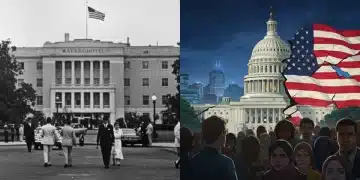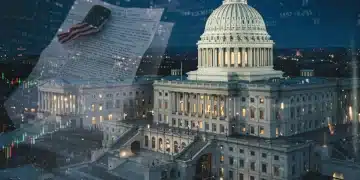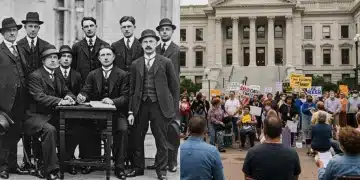US Political Polarization: 1800s to 2025 Outlook

The evolution of US political polarization from the 1800s to today: A 2025 outlook (comparison/analysis) reveals a complex interplay of historical divides, ideological shifts, and modern influences, shaping the nation’s political landscape into an increasingly fractured state.
As of today, the landscape of American politics is undeniably marked by deep divisions. The question of how we arrived at this point, and what the future holds, is central to understanding the nation’s trajectory. This report examines The Evolution of US Political Polarization from the 1800s to Today: A 2025 Outlook (Comparison/Analysis), tracing its historical roots and analyzing the forces shaping its current intensity.
Historical Roots of US Political Polarization: The 19th Century Divide
The concept of political polarization is not new to the United States. While often perceived as a modern phenomenon, its origins can be traced back to the nation’s very foundation. The 19th century, in particular, witnessed profound ideological splits that set precedents for future political battles.
Early American politics, even after the unifying struggle for independence, quickly developed factions. The Federalists and Anti-Federalists, for instance, represented stark differences in their visions for the new republic, particularly concerning the balance of power between federal and state governments.
Slavery and Sectionalism: The Ultimate Divide
Perhaps the most significant and ultimately violent period of polarization in the 19th century revolved around the issue of slavery. This moral and economic dilemma created an unbridgeable chasm between the agrarian South and the industrializing North, leading to profound political and social fracturing.
- Economic Disparity: The North’s industrial growth contrasted sharply with the South’s reliance on slave-based agriculture, creating divergent economic interests.
- Moral Imperatives: Abolitionist movements gained traction in the North, clashing with the South’s defense of slavery as a constitutional right and an economic necessity.
- States’ Rights vs. Federal Power: The debate over slavery often manifested as a struggle over states’ rights, further entrenching regional identities and political stances.
This period culminated in the Civil War, a stark reminder of how deeply entrenched political and ideological differences can become, capable of tearing the nation apart. The Reconstruction era that followed also saw intense polarization, as efforts to integrate freed slaves and rebuild the South met with significant resistance, leaving a legacy of racial and political division that continues to resonate.
The Mid-20th Century: A Period of Relative Bipartisanship and Shifting Coalitions
Following the tumultuous early 20th century, including the Great Depression and two World Wars, the mid-20th century is often viewed through a lens of relative political consensus. While disagreements persisted, a certain degree of bipartisan cooperation characterized American politics, particularly on foreign policy and major domestic programs.
This era saw significant policy achievements, such as the New Deal and the Civil Rights Act, which, despite fierce opposition, ultimately garnered broad support across the political spectrum. The political parties themselves were less ideologically pure, with conservative Democrats and liberal Republicans coexisting within their respective ranks.
The Rise of the Modern Conservative Movement
However, beneath this veneer of consensus, forces were at play that would eventually contribute to renewed polarization. The mid-century saw the nascent stages of the modern conservative movement, a reaction to the expansive role of government ushered in by the New Deal and a growing concern over cultural shifts.
- Anti-Communism: The Cold War fostered a strong anti-communist sentiment that unified conservatives and became a powerful political force.
- Individual Liberty: A renewed emphasis on individual liberty and limited government began to challenge the prevailing liberal consensus.
- Cultural Conservatism: Concerns over changing social norms and values started to coalesce into a distinct political identity.
These developments laid the groundwork for future ideological realignments, particularly as the Democratic Party began to embrace civil rights more fully, leading to a significant shift in the South from Democratic to Republican allegiance. This realignment fundamentally altered the geographical and ideological composition of both major parties, setting the stage for increased partisan sorting.
Late 20th Century: Ideological Sorting and Media Fragmentation
The latter half of the 20th century marked a critical juncture in the evolution of US political polarization. The ideological distinctions between the Democratic and Republican parties became sharper, moving away from the more heterogenous coalitions of the mid-century. This process, often referred to as ideological sorting, meant that liberals increasingly became Democrats and conservatives increasingly became Republicans.
Concurrently, the media landscape began to fragment. The advent of cable television, particularly the rise of partisan news channels, offered consumers more choices and, crucially, allowed them to select news sources that reinforced their existing viewpoints. This contributed to the creation of echo chambers, where individuals were less exposed to alternative perspectives.
Technological Advancements and Echo Chambers
The emergence of the internet and subsequently social media platforms accelerated this trend dramatically. Algorithms designed to maximize engagement often prioritize content that confirms a user’s biases, further isolating individuals within self-reinforcing information bubbles.
- Targeted Messaging: Political campaigns and interest groups leveraged new technologies to deliver highly specific messages to segmented audiences, intensifying partisan appeals.
- Decline of Local News: The erosion of local news outlets reduced common sources of information and community-based civic engagement.
- Rise of Outrage Culture: The speed and anonymity of online platforms often amplify extreme voices and foster an environment of outrage, making nuanced discussion difficult.
These technological shifts, combined with the increasing ideological purity of the parties, created a feedback loop that continues to deepen political divisions. The ability for individuals to exist almost entirely within their preferred ideological media ecosystem makes bridging divides increasingly challenging, as common ground becomes harder to find.
The 21st Century: Hyper-Partisanship and Cultural Warfare
Entering the 21st century, US political polarization intensified, characterized by what many observers describe as hyper-partisanship. This era has seen a dramatic increase in negative partisanship, where animosity towards the opposing party often outweighs positive feelings towards one’s own. Political battles frequently transcend policy debates, morphing into broader cultural warfare.
Major events, such as the 9/11 attacks, the Iraq War, the 2008 financial crisis, and the election of Barack Obama, each served to further entrench partisan divides. Policy disagreements over healthcare, immigration, and climate change became highly charged, often framed as existential threats by opposing sides rather than opportunities for compromise.
Impact of Economic Inequality and Demographic Shifts
Underlying much of this hyper-partisanship are significant economic and demographic changes. Growing income inequality has fueled resentment and a sense of disenfranchisement among various segments of the population, leading to populist movements on both the left and the right. Demographic shifts, particularly changes in racial and ethnic composition, have also been weaponized in political discourse, exacerbating cultural anxieties.
- Economic Dislocation: Globalization and automation have led to job losses in certain sectors, creating economic anxieties that are often politicized.
- Generational Divides: Younger generations often hold different political and social values than older generations, leading to intergenerational clashes within the political sphere.
- Urban-Rural Split: A widening cultural and political chasm between urban and rural areas contributes to distinct political identities and priorities.
The combination of these factors has created a political environment where compromise is often seen as a betrayal, and the opposing party is viewed not just as a competitor, but as an enemy. This deep-seated animosity makes governance difficult and poses significant challenges to democratic institutions.

Comparison: 19th Century vs. 21st Century Polarization
While both the 19th and 21st centuries experienced profound political polarization, a comparative analysis reveals both striking similarities and crucial differences. The 19th century’s defining cleavage was slavery, an issue so fundamental it led to civil war. Today, the divides are multifaceted, encompassing cultural, economic, and ideological dimensions, though perhaps lacking a single, universally acknowledged existential threat.
In the 19th century, geographical divisions were paramount, with distinct Northern and Southern political economies. Today, while urban-rural splits persist, polarization is more distributed across geographies, often reflecting nationalized cultural and ideological battles rather than purely regional interests. The nature of information consumption also differs dramatically, with modern media exacerbating echo chambers at an unprecedented scale.
Key Differences in Manifestation
The mechanisms of polarization have evolved considerably. In the 19th century, information dissemination was slower, and political discourse was often localized or limited to print. The 21st century’s digital age, however, allows for instantaneous global communication, which can both unify and divide on a massive scale.
- Information Flow: 19th-century polarization was shaped by slower, localized information. 21st-century polarization is amplified by rapid, global, and often algorithmic information spread.
- Party Structure: 19th-century parties were often more fluid and less ideologically rigid. Modern parties exhibit high levels of ideological sorting, making bipartisan cooperation rarer.
- Nature of Conflict: While the 19th century saw physical conflict, modern polarization manifests more through political gridlock, social media warfare, and increasing distrust in institutions.
Despite these differences, a common thread remains: when fundamental values or economic systems are perceived to be under threat, political divisions deepen dramatically. Both eras underscore the fragility of national unity when core societal questions remain unresolved or are exploited for political gain. Understanding these parallels and divergences is crucial for addressing contemporary challenges.
A 2025 Outlook: Navigating Continued Polarization
Looking ahead to 2025, the trajectory suggests that US political polarization will likely remain a dominant feature of the national landscape. Several factors indicate a continuation of current trends, although the exact manifestations may evolve. The upcoming presidential election cycle, already underway, is poised to further entrench existing divisions, as both parties mobilize their bases with increasingly stark rhetoric.
Technological advancements, particularly in artificial intelligence and deepfake capabilities, pose new challenges to information integrity, potentially exacerbating disinformation and further fragmenting public trust. The digital sphere will continue to be a primary battleground for ideological contestation, making it harder to establish shared facts or common narratives.
Potential Mitigating Factors and Persistent Challenges
While the outlook appears challenging, potential mitigating factors exist. Increased awareness of the harms of polarization, coupled with efforts from civil society and non-partisan organizations, could foster initiatives aimed at bridging divides. However, these efforts face an uphill battle against deeply entrenched partisan identities and the structural incentives that reward uncompromising political behavior.
- Economic Headwinds: Ongoing economic uncertainties, including inflation and global supply chain issues, could either unite the public in search of solutions or intensify blame and partisan recrimination.
- Geopolitical Tensions: External threats or major international crises might temporarily foster national unity, as seen in past historical periods, but such unity is often fleeting.
- Generational Shift: Younger voters, who are increasingly diverse and often hold different political priorities, could gradually reshape the political landscape, though this is a long-term prospect rather than a near-term solution.
Ultimately, the 2025 outlook suggests a continued struggle for national cohesion. The nation will likely contend with persistent legislative gridlock, intensified cultural debates, and an ongoing challenge to find common ground amidst deeply held and increasingly divergent political identities. The ability of democratic institutions to adapt and respond to these pressures will be critically tested in the years to come.
| Key Point | Brief Description |
|---|---|
| 19th Century Roots | Slavery and sectionalism created profound, often violent, ideological and economic divides, culminating in the Civil War. |
| Mid-20th Shift | Period of relative bipartisanship gave way to ideological sorting and the rise of modern conservatism. |
| Modern Drivers | Media fragmentation, social media, economic inequality, and demographic shifts intensify current hyper-partisanship. |
| 2025 Outlook | Continued polarization anticipated, driven by election cycles, technological challenges, and deep cultural divides. |
Frequently Asked Questions About US Political Polarization
The 19th century’s polarization centered largely on the singular, existential issue of slavery and regional economies. In contrast, 21st-century polarization is characterized by a complex interplay of ideological, cultural, economic, and media-driven factors, making it more diffuse and less geographically defined.
Media fragmentation, particularly with cable news and social media, allowed individuals to consume news reinforcing existing biases. This created echo chambers, limiting exposure to diverse viewpoints and fostering a sense of ‘us vs. them’ by amplifying partisan narratives and outrage culture.
Economic inequality and dislocation from globalization and automation fuel resentment and populist movements. These economic anxieties are often politicized, leading to stark partisan divisions over policy solutions and contributing to a sense of disenfranchisement among various groups.
The mid-20th century is often cited as a period of relative bipartisanship, particularly after World War II. While disagreements existed, there was more cross-party cooperation on major domestic and foreign policies, with less ideological sorting within the parties compared to today.
The 2025 outlook anticipates continued legislative gridlock, intensified cultural warfare, and challenges to information integrity due to advanced technologies like AI. Overcoming deep partisan identities and finding common ground amidst divergent political priorities will be paramount.
Looking Ahead: The Enduring Challenge of Division
As the United States moves towards 2025, the analysis of its political polarization from the 1800s to today reveals a persistent and evolving challenge. The current environment, marked by hyper-partisanship and cultural clashes, demands vigilant observation and proactive engagement. The upcoming election cycles and ongoing technological advancements are set to test the resilience of democratic institutions and the capacity for national cohesion. Understanding these historical patterns and contemporary drivers is essential for navigating the complex political landscape and seeking pathways toward a more unified future.





